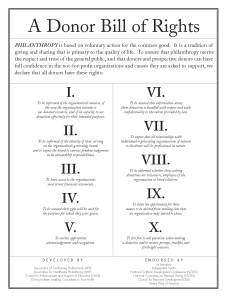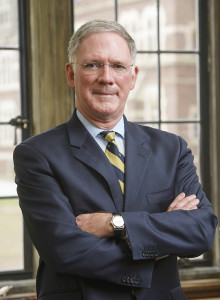
The Donor Bill of Rights is a document adopted by the Council for the Advancement and Support of Education, the Association of Fundraising Professionals and the Giving Institute, an association of consultants for nonprofits.
The Donor Bill of Rights was developed so that donors — and the staff and volunteers who work with them — are aware of their rights.
Philanthropy
PHILANTHROPY is based on voluntary action for the common good. It is a tradition of giving and sharing that is primary to the quality of life. To assure that philanthropy merits the respect and trust of the general public, and that donors and prospective donors can have full confidence in the not-for-profit organizations and causes they are asked to support, we declare that all donors have these rights:
I
To be informed of the organization’s mission, of the way the organization intends to use donated resources, and of its capacity to use donations effectively for their intended purposes.
II
To be informed of the identity of those serving
on the organization’s governing board,
and to expect the board to exercise prudent
judgment in its stewardship responsibilities.III
To have access to the organization’s
most recent financial statements.IV
To be assured their gifts will be used for
the purposes for which they were given.V
To receive appropriate acknowledgement
and recognition.VI
To be assured that information about their
donations is handled with respect and with
confidentiality to the extent provided by law.VII
To expect that all relationships with
individuals representing organizations of interest
to the donor will be professional in nature.VIII
To be informed whether those seeking
donations are volunteers, employees of the
organization or hired solicitors.IX
To have the opportunity for their
names to be deleted from mailing lists that
an organization may intend to share.X
To feel free to ask questions when making
a donation and to receive prompt, truthful and
forthright answers.
I believe in these rights. As a member of the Association of Fundraising Professionals, AFP, I sign a code of ethics to support them. I operated under this code when I worked for Sweet Briar College in the 1990s, and helped raise a number of leadership gifts which make up the current endowment. I believe that the actions of the Sweet Briar Board of Directors to close the College and attempt to utilize the endowment for purposes other than that which the donor’s intended, is unethical. Shortly before this post, Ellen Brower, Amherst County Attorney, filed suit asserting that this breaks Virginia State Law.
So what is the issue at Sweet Briar? It comes down to a plan on the part of the President and Board of Directors to tap into the endowment. Why is this a problem? Read on….
Endowment
Webster defines endowment as:
: a large amount of money that has been given to a school, hospital, etc., and that is used to pay for its creation and continuing support
: the act of providing money to create or support a school, organization, etc.
: a person’s natural ability or talent
Endowment: Unrestricted and Restricted Gifts
As a donor, I have left Sweet Briar College in my will as a beneficiary of funds (this is currently being revised). I have not left any particular purpose for those funds (this is currently being revised). When someone makes a gift to an endowment and does not have a specific purpose for the funds, that is called “unrestricted”. Unrestricted funds, pooled together, generate income used by Colleges, Universities and nonprofits for operating costs.
Restricted gifts to endowment are made to achieve specific goals. Endowed scholarships (usually have a minimum) are created and the interest provides scholarships for students. Endowed funds for specific purposes generate income for those programs annually. Endowed professorships support a portion of a professor’s income or fund research projects.
As a former employee of Sweet Briar College, I worked with many donors who made contributions to the College’s endowment. In fact, nearly ALL of the $13 million raised from Regional Campaigns around the country was to build endowment. The agreements people signed at the time talked about funds being used for student scholarship, program enhancement and a few other priorities. I feel a sense of duty to those donors with whom I sat thoughtfully and provided written agreements assuring them of the endowment’s strength and legacy.
Endowment Spending
Boards of Directors – fiscal agents for an institution – have spending policies that determine the amount that can be spent from the endowment. A healthy spending rate is thought to be between 3-5%, even in good years. The idea is that some years investments will be up, sometimes down, and a smoothing effect of taking a smaller amount ensures for the long-term success of the funds.
At Sweet Briar, the Board’s spending rate has been a higher 8% as the operating budget needed more income. This is not healthy or sustainable, but there is nothing wrong with it.
Endowment Raiding
I never thought I would write on the topic of “endowment raiding”, but the intentions of the Sweet Briar College Board of Directors forces me to do so.
The Sweet Briar College Board of Directors voted to close the College and “wind down operations” including seeking legal intervention in order to tap into its endowment to provide severance packages, debt payments and other things unrelated to what donors intended. This action is also inconsistent with the mission of the College.
Apart from my being horrified at such a sudden move by the Board (I have written about this topic on another thread), I am personally and professionally sickened by this action. It is unethical and unnecessary. I picture the donors with whom I worked. Many of them are no longer living. Others are contacting me by phone and on Facebook imploring me to do something (one of the reasons I have written this post). Many of those donors no longer trust the people they worked with in the Development Office. Who would?
Donors who give to endowment give with the idea that they are creating a legacy and are making a gift in perpetuity. The memory of many dear people will be violated if the Board of Directors is successful.
Pledge Forms, Memorandum of Understanding, Gift Contracts
There are legal agreements which back up major gifts to any institution. That is also the case for Sweet Briar. Campaign Pledge Forms are legal documents with donor’s intent captured and co-signatures by campus officials. Memorandum of Understanding are draw up for more complex gift agreements. Letters of Agreement are drawn up for many five and six figure contributions. In short, to try to “unrestrict” an endowment, these legal agreements will need to be properly revisited. It is also not the case that a College or University can go to the heirs of someone and ask that funds be revisited. There are many examples of courts upholding an original donor’s intent and rejecting even signed agreements made with decendents (unless the original donors outlines those who can make decisions for them later). Trying to get children or family members to sign something should not be grounds to use funds in a way contrary to a donor’s intent. Yet, as I write, the staff of the College are doing just this.
Donor Bill of Rights Violated
Of all of the rights of donors (a full copy of the rights are above), those I think are most important are the following:
II
To be informed of the identity of those serving
on the organization’s governing board,
and to expect the board to exercise prudent
judgment in its stewardship responsibilities.III
To have access to the organization’s
most recent financial statements.IV
To be assured their gifts will be used for
the purposes for which they were given
To make any attempts to unrestrict endowment is violating not only Section II of the Donor Bill of Rights, but also Section IV. Furthermore, the behavior by staff or administrators to take these action is a violation of the professional code of conduct.
Board of Directors and administrators taking these actions shakes the very foundation of philanthropy. Donors and prospective donors should have full confidence in the not-for-profit organizations and causes they are asked to support. I feel my own professional reputation is harmed by the stated plans of Sweet Briar College.
The only way to protect donor intent in this case is legal action on behalf of those donors. I am grateful that SavingSweetBriar.com is taking on the important stewardship of these gifts. It is sad that the Alumnae Association has not made more public statements condemning the plan.
On the heels of this, it also seems appropriate to advocate for stronger State and Federal law to protect donors. But that is for another chapter of Being UnLocked….
Stacey Sickels Locke is a proud graduate of Sweet Briar College, Class of 1988. She served as an employee of the College in the early 1990s working on the $25 million Campaign. During that time, she solicited many leadership gifts which make up the current endowment and she feels a sense of duty that those donations are not used for the closure of the College or for any other purposes than the donors intended. Since then, she has spent her career building support for higher education and the nonprofit community as a staff member and consultant for boards. As a volunteer, she has served Sweet Briar since graduation as a fundraiser, admissions ambassador and now advocate for the #saveSweetBriar movement. She is a member of the Association of Fundraising Professionals (AFP), the Council for the Advancement and Support of Education (CASE) and holds a Certified Fund Raising Executive (CFRE) certification from CFRE International.

Share this....

















